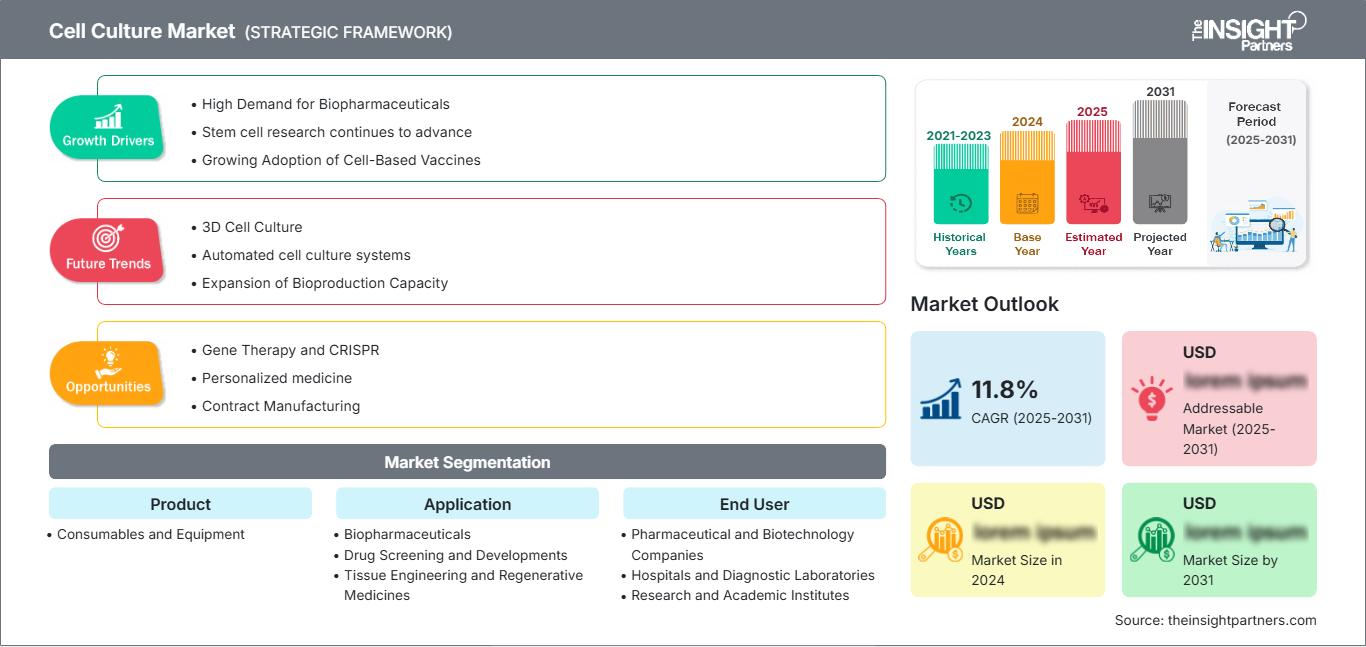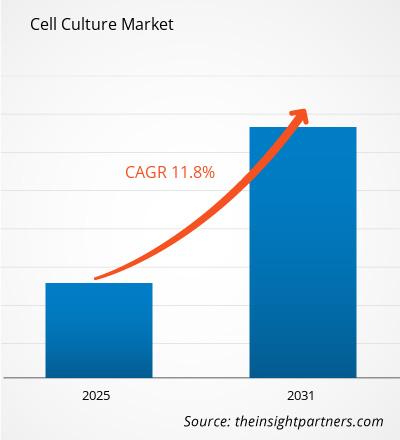Si prevede che il mercato delle colture cellulari raggiungerà i 61,12 miliardi di dollari entro il 2031. Si prevede che il mercato registrerà un CAGR del 10,7% nel periodo 2025-2031.
Il mercato delle colture cellulari è suddiviso per prodotto nei seguenti sottosegmenti: materiali di consumo, attrezzature. Presenta inoltre un'analisi basata sull'applicazione, ovvero prodotti biofarmaceutici, screening e sviluppo di farmaci, ingegneria tissutale e medicina rigenerativa, diagnostica e altri; e sull'utente finale, ovvero aziende farmaceutiche e biotecnologiche, ospedali e laboratori diagnostici, istituti di ricerca e accademici e altri. L'analisi globale è suddivisa a livello regionale e per principali paesi. La valutazione di mercato è presentata in dollari USA per l'analisi segmentale di cui sopra.
Scopo del rapporto
Il rapporto "Cell Culture Market" di The Insight Partners mira a descrivere il panorama attuale e la crescita futura, i principali fattori trainanti, le sfide e le opportunità. Ciò fornirà spunti a vari stakeholder aziendali, come:
- Fornitori/Produttori di tecnologia: per comprendere le dinamiche di mercato in evoluzione e conoscere le potenziali opportunità di crescita, consentendo loro di prendere decisioni strategiche informate.
- Investitori: per condurre un'analisi completa delle tendenze in merito al tasso di crescita del mercato, alle proiezioni finanziarie di mercato e alle opportunità esistenti lungo la catena del valore.
- Enti di regolamentazione: per regolamentare le politiche e le attività di controllo sul mercato con l'obiettivo di ridurre al minimo gli abusi, preservare la fiducia degli investitori e sostenere l'integrità e la stabilità del mercato.
Segmentazione del mercato delle colture cellulari Prodotto
- Materiali di consumo e attrezzature
Applicazione
- Biofarmaceutici
- Screening e sviluppo di farmaci
- Ingegneria tissutale e medicina rigenerativa
- Diagnostica
- Altri
Utente finale
- Aziende farmaceutiche e biotecnologiche
- Ospedali e laboratori diagnostici
- Istituti di ricerca e accademici
- Altri
Geografia
- Nord America
- Europa
- Asia-Pacifico
- Sud e Centro America
- Medio Oriente e Africa
Potrai personalizzare gratuitamente qualsiasi rapporto, comprese parti di questo rapporto, o analisi a livello di paese, pacchetto dati Excel, oltre a usufruire di grandi offerte e sconti per start-up e università
Mercato delle colture cellulari: Approfondimenti strategici

- Ottieni le principali tendenze chiave del mercato di questo rapporto.Questo campione GRATUITO includerà l'analisi dei dati, che vanno dalle tendenze di mercato alle stime e alle previsioni.
Fattori di crescita del mercato delle colture cellulari
- Elevata domanda di prodotti biofarmaceutici: la domanda di farmaci biologici, come anticorpi monoclonali e vaccini, continua a essere elevata, tanto da richiedere tecnologie di coltura cellulare nello sviluppo e nella produzione di farmaci.
- La ricerca sulle cellule staminali continua a progredire: la ricerca sulle cellule staminali è in continuo progresso, con lo sviluppo della ricerca sulle cellule staminali e sulla medicina rigenerativa che ha dato un enorme impulso alla domanda di prodotti e metodi di coltura cellulare.
- Crescente adozione di vaccini basati su cellule: l'adozione di vaccini basati su cellule è aumentata, soprattutto durante la pandemia di COVID-19. Con questo aumento nell'adozione, è aumentata anche la domanda di tecnologie di coltura cellulare nella formulazione dei vaccini.
Tendenze future del mercato delle colture cellulari
- Coltura cellulare 3D: poiché riproducono in modo più accurato gli ambienti in vivo rispetto alle colture 2D standard, l'uso di sistemi di coltura cellulare 3D è diventato sempre più di tendenza al giorno d'oggi, poiché appaiono anche più predittivi nella scoperta di farmaci e nei test di tossicità.
- Sistemi di coltura cellulare automatizzati: la crescente tendenza all'automazione, che significa alimentazione, raccolta e monitoraggio automatizzati delle cellule, ha reso il processo di coltura cellulare più efficiente e riproducibile.
- Espansione della capacità di bioproduzione: ampliare la capacità di bioproduzione a causa della crescente domanda di prodotti biologici e della crescente dipendenza da sistemi di coltura cellulare scalabili per la produzione di prodotti biologici di alta qualità.
Opportunità di mercato per le colture cellulari
- Terapia genica e CRISPR: le terapie geniche e l'editing genetico con tecnologie come CRISPR apriranno le porte alle tecnologie di coltura cellulare, che potranno svolgere un ruolo chiave nella maggior parte degli studi di ricerca e sviluppo.
- Medicina personalizzata: i sistemi di coltura cellulare saranno molto importanti nello sviluppo di trattamenti specifici per il paziente, soprattutto nella ricerca sul cancro e nell'immunoterapia con lo sviluppo della medicina personalizzata.
- Produzione a contratto: la domanda di prodotti biologici basati su colture cellulari offre alle aziende l'opportunità di offrire servizi di produzione a contratto, soprattutto nel crescente mercato dei biosimilari.
Mercato delle colture cellulari
Le tendenze regionali e i fattori che influenzano il mercato delle colture cellulari durante il periodo di previsione sono stati ampiamente spiegati dagli analisti di The Insight Partners. Questa sezione illustra anche i segmenti di mercato e la geografia della gestione delle malattie del ritmo cardiaco in Nord America, Europa, Asia-Pacifico, Medio Oriente e Africa, America meridionale e centrale.
Ambito del rapporto sul mercato delle colture cellulari
| Attributo del rapporto | Dettagli |
|---|---|
| Dimensioni del mercato in 2024 | US$ XX Billion |
| Dimensioni del mercato per 2031 | US$ 61.12 Billion |
| CAGR globale (2025 - 2031) | 10.7% |
| Dati storici | 2021-2023 |
| Periodo di previsione | 2025-2031 |
| Segmenti coperti |
By Prodotto
|
| Regioni e paesi coperti | Nord America
|
| Leader di mercato e profili aziendali chiave |
|
Densità degli operatori del mercato delle colture cellulari: comprendere il suo impatto sulle dinamiche aziendali
Il mercato delle colture cellulari è in rapida crescita, trainato dalla crescente domanda degli utenti finali, dovuta a fattori quali l'evoluzione delle preferenze dei consumatori, i progressi tecnologici e una maggiore consapevolezza dei benefici del prodotto. Con l'aumento della domanda, le aziende stanno ampliando la propria offerta, innovando per soddisfare le esigenze dei consumatori e sfruttando le tendenze emergenti, alimentando ulteriormente la crescita del mercato.

- Ottieni il Mercato delle colture cellulari Panoramica dei principali attori chiave
Punti di forza
- Copertura completa: il rapporto copre in modo completo l'analisi di prodotti, servizi, tipologie e utenti finali del mercato delle colture cellulari, fornendo un panorama olistico.
- Analisi degli esperti: il rapporto è compilato sulla base della conoscenza approfondita di esperti e analisti del settore.
- Informazioni aggiornate: il rapporto garantisce rilevanza aziendale grazie alla sua copertura di informazioni recenti e tendenze dei dati.
- Opzioni di personalizzazione: questo rapporto può essere personalizzato per soddisfare le esigenze specifiche del cliente e adattarsi in modo appropriato alle strategie aziendali.
Il rapporto di ricerca sul mercato delle colture cellulari può, quindi, aiutare a guidare il percorso di decodificazione e comprensione dello scenario del settore e delle prospettive di crescita. Sebbene possano esserci alcune preoccupazioni valide, i vantaggi complessivi di questo rapporto tendono a superare gli svantaggi.
- Analisi storica (2 anni), anno base, previsione (7 anni) con CAGR
- Analisi PEST e SWOT
- Valore/volume delle dimensioni del mercato - Globale, Regionale, Nazionale
- Industria e panorama competitivo
- Set di dati Excel
Report recenti
Rapporti correlati
Testimonianze
Motivo dell'acquisto
- Processo decisionale informato
- Comprensione delle dinamiche di mercato
- Analisi competitiva
- Analisi dei clienti
- Previsioni di mercato
- Mitigazione del rischio
- Pianificazione strategica
- Giustificazione degli investimenti
- Identificazione dei mercati emergenti
- Miglioramento delle strategie di marketing
- Aumento dell'efficienza operativa
- Allineamento alle tendenze normative




















 Ottieni un campione gratuito per - Mercato delle colture cellulari
Ottieni un campione gratuito per - Mercato delle colture cellulari